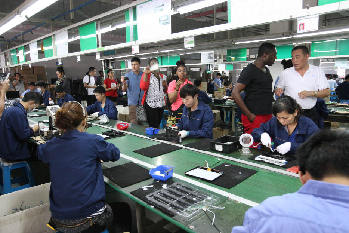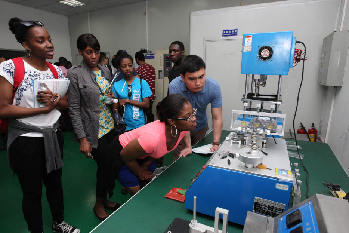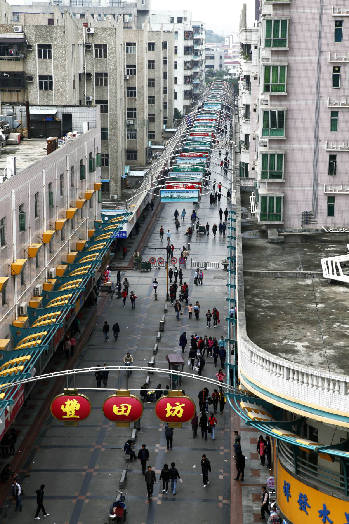Yantian presents a different example of development.
Asian and African Observers of the Yantian Miracle
By staff reporter ZHOU LIN
 |
|
|
YANTIAN Village of Dongguan City in southern China’s Pearl River Delta, which has been transformed from vast paddy fields into a thriving, manufacturing center, is coming into sharp focus as it rides on the wave of China’s rise. In 2012, Professor Anthony Saich from Harvard Kennedy School and Professor Hu Biliang, dean of the Emerging Markets Institute of Beijing Normal University (BNU), jointly wrote a book entitled Chinese Village, Global Market: New Collectives and Rural Development, which vividly describes Yantian’s transition over the past three decades.
Twenty-eight officials from 14 developing countries studying an IMBA program at BNU’s Emerging Markets Institute conducted a field investigation in Yantian Village in June 2015 and shared their observations and discussions on its development. Their informed perspectives give us a clearer picture of the dramatic changes that have taken place in China since the policy of reform and opening-up, and can help forecast the nation’s future prospects.
Foreign Direct Investment from the Global Market
Yantian Village is located in the southernmost town of Fenggang of Dongguan City in Guangdong Province, with Shenzhen City to its east, south, and west, and covers an area of 24 square kilometers. It is just 30 minutes’ drive from Luohu Checkpoint and Shenzhen Bao’an International Airport. The village has administration over nine villager groups and a population of 3,000 registered permanent residents.
After the establishment of Shenzhen Special Economic Zone in 1980, the lives of Yantian villagers totally changed. The advantageous location of the village, adjacent to both Shenzhen and Hong Kong, and its cheap land and workforce made it a preferential district to attract foreign direct investment, especially for manufacturing enterprises in Hong Kong.
In 1980, Lü Zhengfu, a businessman born in Huiyang City of Guangdong Province who later moved to Hong Kong, was considering investing in his hometown. However, he realized that the conditions there were not right; the town was not mature enough for what he had in mind. Then, on his way back to Hong Kong, he happened to discover that Yantian Village had a much more convenient market and incentive policies. He opened Zhengxin Wool Mill in Yantian’s 60-meter-long, 10-meter-wide village meeting hall, giving birth to the first Hong Kong-invested “Three-plus-one” trading-mix enterprise, whose major business comes from custom manufacturing with materials, designs or samples supplies, and compensation trade. This business model was created when the Chinese government adopted the policy of reform and opening-up with the intention of attracting foreign investment in various forms. The first year Zhengxin Wool Mill was in operation, it had good economic performance: the village collective gained a net income of RMB 250,000. Later, from 1992 to 1995, Yantian Village built 180 factories and five industrial parks. On its 24 square kilometers of land, enterprises in the fields of electronics, computers, machine-building, clothing, toys, and wristwatches sprang up like mushrooms after rain.
The success of Zhengxin Wool Mill has further inspired Yantian’s villagers, who are keen to attract more foreign investment. It has also set a good example for entrepreneurs of the Deng family in Hong Kong, whose forefathers formed the biggest clan of Yantian Village and whose offspring still hold a dominant role in the village today. Traditionally, overseas Chinese eventually return home after retirement to live out their days, seen as a homecoming to their wider families. Therefore, from 1981, Deng clan members who went to Hong Kong to escape the poverty began returning home, bringing their successful businesses with them. By the end of 1985, there were 10 such foreign-funded companies. These entrepreneurs’ endeavors paved the way for more investors from Hong Kong, Taiwan, Japan, Germany, and the U.S., and by the end of 1998, the total number of foreign-invested enterprises reached 430. Meanwhile, entrepreneurs from across the country began to invest in Yantian, and the total number of private enterprises reached 700.
 |
|
Officials from developing countries visit the Yanghua Digital Technology Co., Ltd. |
“Attracting such a level of foreign direct investment was the turning point of the village,” Chakra Prasad Paneru, an official of Nepal’s Revenue Investigation Regional Office, said. “These foreign-invested enterprises brought a large amount of substantive earnings for villagers, including the money needed to rent land and premises.”
Hassan Mohamed Haji, an officer with the Tanzanian police force, is convinced that it’s a win-win situation. Enterprises with investments from Hong Kong, Taiwan and foreign countries have enjoyed Yantian’s unique geographical advantages, preferential policies and low-cost labor force, and have also brought opportunities for the small village, including abundant capital, advanced technology, marketing information, and management expertise.
In 1994, Yantian Village featured on China’s prominent economic village list. By the end of 2014, the total assets of Yantian Village reached RMB 2.83 billion, with a net asset of RMB 2.34 billion. In 2014, the village collective net income was RMB 190 million, among which RMB 72.36 million was given to individuals as dividend, and the per capita dividend was as high as RMB 24,000. According to an investigation several years ago, villagers’ dividend took up 25 percent of their total income. Thus, the villagers’ net income per capita was about RMB 100,000; one farm household’s annual net income reached RMB 350,000.
Inland Migrants: More Opportunities and Better Insurance
With abundant foreign enterprises and inland companies, Yantian Village’s demand for labor has increased. A village with 3,000 permanent residents has developed into a business center with a population of nearly 100,000. Apart from around 1,500 local villagers engaged in the non-farming economy, 60,000 laborers from around the nation have found job opportunities in the small village. The migrants work and live in Yantian and have contributed to its status as a prosperous town.
The expanding population has increased the demand for medical and health care services. A diversified welfare structure has hence been formed, in which the government, the private sectors, and the village collective participate in various modes. Currently, there is a public hospital, a public community health station, a large private hospital, and 17 private medical institutes, jointly providing medical services to all Yantian residents, locals and migrants alike.
Indeed, today one of the most famous hospitals in Yantian is the well-equipped private Southern Medical University Guangji Hospital, which has top medical apparatus and instruments, and a team of doctors selected from renowned hospitals around China. A new health insurance system especially for migrants guarantees inexpensive medicines and the same level of care as for locals.
Isaac Barimah Amponsah from Ghana’s Ministry of Energy attributed the “Yantian Miracle” to the decisive role of the private sector, pointing out that in Yantian Village it has addressed some of the developmental challenges via economic growth, job opportunities, poverty reduction, public services, and contributions to local taxation.
“The Yantian Miracle is an outstanding merit not only of village authorities but also of a hardworking migrant labor force. People from nearby areas and inland provinces have found a second home in Yantian and are able to support their families at home by sending money back,” said Sardarbek Mairykov from Kyrgyzstan, a finance assistant of the United Nations World Food Program.
Vannasy Phonehanheuang, an official from the Ministry of Planning and Investment of Laos, agreed and offered an indepth analysis on the impact of migration. It is generally recognized that a large number of people moving from the countryside to the city, from economically underdeveloped areas to developed areas, are influenced by such factors as “expected earning opportunities,” “personal development aspirations,” and “urban lifestyle.” However, migrants in Yantian are quite different since they have moved from big cities to the rural village. Yantian offers migrants more opportunities and better social insurance.
Apelu Ioasa, a principal auditor from the Ministry of Education of Samoa, told the reporter that the idea of setting up private schools or private hospitals following the Yantian model would be a suitable strategy to improve the economies of developing countries like Samoa. As Samoa’s main source of income is from agriculture and tourism, and these sectors are facing bigger challenges, Samoa must try to promote the service sector. Samoa is vulnerable to natural disasters like tsunamis, typhoons and floods which pose severe harm to agriculture and tourism. Also, overseas economic shocks can easily affect Samoa’s economy in terms of reduction in remittances from Samoans who live overseas.
|
|
|
A pedestrian street named Fengtian Alley in Yantian Village. |
Village Collective Development with Chinese Characteristics
According to Ortom David Terdoo, director of Oracle Business Limited of Nigeria, the reason why foreign direct investment can boost Yantian Village’s development lies in its strong leadership, transparent investment policy, convenient infrastructural facilities, and technological development and innovation.
The Deng clan plays a dominant role in the village’s economic and political life. Their successive and successful leadership has become the sustainable momentum of the village collective economy development and they dominate almost every aspect of undertakings. The top village leader has always been a Deng clan member. The clan heads most local enterprises and has taken charge of the villagers’ committee and the stockholding cooperatives, the latter of which actually controls the village land and assets.
At the beginning of China’s opening to the outside world, Yantian Village had far fewer assets. The Deng clan made full use of their relations with overseas family members and relatives and persuaded them to invest in their hometown. To rouse their sense of belonging to their hometown, Yantian Village built a big memorial hall to display the connections among the clan members and celebrate major festivals and so enhance their hometown affections.
Collective land ownership of Yantian Village means that the village collective can reclaim the land distributed to individual villagers and rent it to outside investors and inland enterprises, which is the basis of shareholding economic cooperatives. Villagers also benefit from the annual dividend, depending on their formal registration as permanent residents.
Jonny Mek Kolkia, a lawyer from Papua New Guinea, found it interesting that most small countries are either solely dependent on foreign investment or simply copy international organizations’ advanced experience to seek development. However, China presents a different example. It discovers a development road in accordance with its current situations in various areas, which he considers the most cherished wisdom of Chinese experience.
On April 27, 2015, the Qianhai & Shekou Area of Shenzhen as part of China (Guangdong) Pilot Free Trade Zone held its inauguration ceremony. The 40-minute ride from Yantian Village to Shekou again spurs Yantian Village to incubate a new strategy for future economic development and industrial transformation.
Anishka Bethune comes from the Bahamas and once worked in the CIBC First Caribbean International Bank. She shows a great interest in the Chinese government’s Five-year Plan, “China’s economic development is a constant process divided into different stages. After achieving one goal, the Chinese people are always ready for the next challenge,” Ms. Bethune said.

